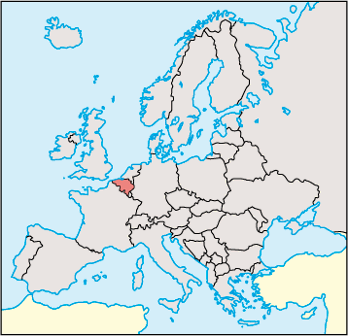What is the Capital of Belgium? Brussels

Brussels is the capital of Belgium, and has 177 112 residents (2018). The city is at the heart of the Brussels metropolitan area, which has 1,191,041 residents (2018). The majority of the residents speak French, but the city is officially bilingual (French and Dutch) and is surrounded by the Dutch-speaking province of Flemish Brabant.
The Brussels Capital Region (La Région de Brussels Capital / Brussels Capital Region) covers 161 km², and consists of Brussels itself and 18 other municipalities, including Schaarbeek in the north, Etterbeek in the east, Ixelles (Elsene) in the southeast, St. Gilles, Uccle (Uccle) and Forest (Vorst) in the south, Anderlecht and Molenbeek-St. Jean in the west, and more. The metropolitan region is Belgium’s third bilingual region, next to the French-speaking Wallonia and the Dutch-speaking Flanders.
Administration and business
Brussels is the administrative, communication and cultural center in Belgium. The city is furthermore the headquarters of the European Union (EU), the seat of the General Secretariat of NATO and of a number of other international organizations and companies. The city is also the center of international banking and has an important stock exchange. Most of the industry is in the suburbs, especially in a belt north-south along the Senne (Zenne) river. The production covers a very wide range: textiles, clothing, machinery, electrical articles, furniture, chemicals and more.
Railways and motorways connect Brussels with all parts of Belgium. The Willebroek canal connects Brussels with Antwerp, and seagoing boats with a depth of up to 6 meters have been able to ascend to the port of Brussels since 1922. The Brussels-Charleroi canal connects the city with the rivers Meuse and Sambre. The international airport is located in Zaventem, northeast of the city.
The university was founded in 1834, and in 1969 was divided into the Dutch-speaking Vrije Universiteit Brussel and the French-speaking Université libre de Brussels. Both universities are located in the southeastern part of the urban area. Brussels also has other higher education institutions and a number of other cultural institutions: art collections including works by the great Flemish masters, museums, theaters, opera (bilingual). Brussels was the European city of culture in the year 2000.
Resorts
Broad bulges form an approximate pentagon around the city core. The boulevards are where the city walls lay until they were demolished (1819-40). Monumental and stylish buildings at parks and places have given Brussels a great reputation for beauty. At the Town Hall Square (Grand Place / Grote Markt) is the Town Hall (Hôtel de Ville / Stadhuis), erected in Gothic style 1402-1454, with a tall tower and richly decorated with sculptures. The place is listed on UNESCO’s List of World Cultural and Natural Heritage. Near the town hall square is the well-known fountain with the bronze statue Manneken Pis. Close to Place Royale and the central park area are the Royal Palace, the National Assembly (Palais de la Nation / Palace of Natie) and most department buildings. The right-wing Gothic Cathedral of St. Michel is famous for, among other things, its stained glass windows. The grand Palais du Cinquantenaire from 1880 was erected in memory of Belgium’s independence in 1830 and now contains rich collections of crafts and archaeological finds. To the north, near the Laeken Park is the Atomium landmark, built for the 1958 World Exhibition.
History
Brussels is mentioned for the first time in the 9th century. In those times, the trade route from Cologne to Bruges was an important traffic artery, and Brussels became a trading post on the border between the Flemish and Walloon lands. The wool industry started, and eventually Brussels became known for its tapestries and lace. Canal facilities promoted connection with the North Sea (Willebroek Canal, completed 1561).
Brussels became the residence of the dukes of Brabant, and when this duchy came under the Habsburg house, the city became the residence of the Spanish governors. The city had heavy times during the Dutch Eighty Years War (1568-1648) and later during Louis 14 of France’s wars, especially during the Palatinate War (1689-1697): In 1695, the French army bombed Brussels, and the city was almost destroyed. However, Brussels recovered well during the Austrian rule of the 18th century.
After the Vienna Congress in 1815, Belgium became part of the Kingdom of the Netherlands, and in this state Brussels changed with the Hague to be the capital. The Belgian uprising in 1830 began in Brussels and ended with Belgium becoming an independent kingdom. Since then, Brussels has been the capital of Belgium.
Brussels was occupied by German forces during both world wars, but was not significantly injured. After World War II, the city gained a prominent place as host city for the EU administration, and from 1967 for NATO headquarters. Domestic politics, the city is characterized by having a predominantly French-speaking population despite being located in a Dutch-speaking area. Following the new Belgian constitution of 1993, Greater Brussels is a separate bilingual province.














































